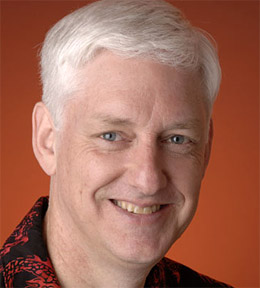A search giant

Berkeley Engineering alum Peter Norvig is director of research at Google, Inc. (Photo by Bart Nagel)
It’s no surprise that a Google search for Peter Norvig turns up tens of thousands of hits.
Norvig (Ph.D. ’86 EECS) literally wrote the book on artificial intelligence, coauthoring with Professor Stuart Russell in 1995 the bestselling textbook Artificial Intelligence: A Modern Approach. As the senior computer scientist at NASA Ames Research Center, he led the team that developed the remote artificial intelligence software that flew aboard the Deep Space 1 spacecraft in 1999. And today, as Google’s director of research, Norvig is transforming the way information is organized and accessed on the Web.
Honoring his leadership, Norvig recently received a 2007 Berkeley Engineering Innovation Award for lifetime achievement.
“I think we’re just getting started,” Norvig says of technology’s potential to disseminate information and improve the quality of life. Convinced that Google’s vast data resources made it an ideal place to pursue search technology, Norvig joined the Mountain View–based company in 2001. He oversees a team of 120 researchers tackling such cutting-edge projects as machine translation of languages, speech recognition, and computer vision, in which computers recognize and identify images in pictures and video.
Norvig’s website, www.norvig.com, offers a window into his pioneering career—along with a glimpse at the lighter side of a technologist with a penchant for bright, Hawaiian-style shirts. In addition to links to Norvig’s artificial intelligence books, programming essays and free open-source software, the main page features categories for humor and his “top dozen links.”
Heading that top 12 list is Norvig’s “Gettysburg Powerpoint Presentation,” a parody he created in 2000 after watching “one too many bad presentations.” It condenses Abraham Lincoln’s illustrious 1863 speech into six simple bullet-pointed slides, bearing such headings as “Agenda,” “Not on Agenda!” and “Review of Key Objectives and Critical Success Factors.” One subheaded bullet reads: “Gov’t of/for/by the people.”
In an essay for the British medical journal The Lancet, Norvig wrote, “Homogeneity is great for milk, but not for ideas. Use visual aids to convey visual information: photographs, charts or diagrams. But do not use them to give the impression that the matter is solved, wrapped up in a few bullet points.” The Gettysburg PowerPoint has attained near-cult status—attracting, by Norvig’s count, some 1.678 million viewers. At Google, Norvig says his staffers give PowerPoint talks but are encouraged to emphasize substance over “fancy presentations.”
Norvig is also the author of the “world’s longest palindrome,” another link off his home page. He wrote an algorithm on February 20, 2002, at 8:02 p.m. (or 20:02 02/20 2002) that produced a 15,319-word phrase reading the same backwards as forwards. “Maybe I’m biased, but I think the palindrome starts out quite strong,” Norvig drolly observes in an accompanying commentary. “‘A man, a plan, a caddy’ is the basic premise of another fine piece of storytelling. Unfortunately, things go downhill from there rather quickly.” In November 2007, Norvig bested that effort with a palindrome totaling 17,826 words.
Yet another homepage link leads to Norvig’s online resume. In a yellow highlighted box, he cautions prospective recruiters: “Please don’t offer me a job. I already have the best job in the world at the best company in the world.”
Not surprisingly, “They still call,” Norvig concedes.
